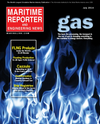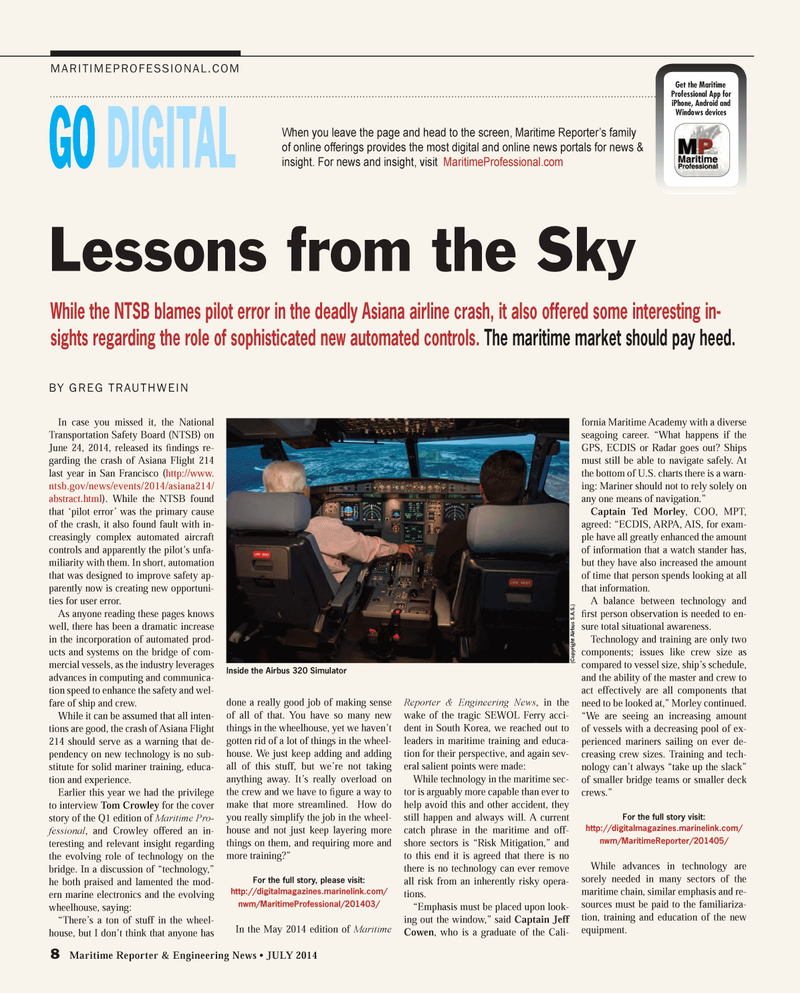
Page 8: of Maritime Reporter Magazine (July 2014)
Offshore Energy Structures & Systems
Read this page in Pdf, Flash or Html5 edition of July 2014 Maritime Reporter Magazine
8 Maritime Reporter & Engineering News • JULY 2014
In case you missed it, the National
Transportation Safety Board (NTSB) on
June 24, 2014, released its fi ndings re- garding the crash of Asiana Flight 214 last year in San Francisco (http://www. ntsb.gov/news/events/2014/asiana214/ abstract.html). While the NTSB found that ‘pilot error’ was the primary cause of the crash, it also found fault with in- creasingly complex automated aircraft controls and apparently the pilot’s unfa- miliarity with them. In short, automation that was designed to improve safety ap- parently now is creating new opportuni- ties for user error.
As anyone reading these pages knows well, there has been a dramatic increase in the incorporation of automated prod- ucts and systems on the bridge of com- mercial vessels, as the industry leverages advances in computing and communica- tion speed to enhance the safety and wel- fare of ship and crew.
While it can be assumed that all inten- tions are good, the crash of Asiana Flight 214 should serve as a warning that de- pendency on new technology is no sub- stitute for solid mariner training, educa- tion and experience.
Earlier this year we had the privilege to interview Tom Crowley for the cover story of the Q1 edition of Maritime Pro- fessional, and Crowley offered an in- teresting and relevant insight regarding the evolving role of technology on the bridge. In a discussion of “technology,” he both praised and lamented the mod- ern marine electronics and the evolving wheelhouse, saying: “There’s a ton of stuff in the wheel- house, but I don’t think that anyone has done a really good job of making sense of all of that. You have so many new things in the wheelhouse, yet we haven’t gotten rid of a lot of things in the wheel- house. We just keep adding and adding all of this stuff, but we’re not taking anything away. It’s really overload on the crew and we have to fi gure a way to make that more streamlined. How do you really simplify the job in the wheel- house and not just keep layering more things on them, and requiring more and more training?”
For the full story, please visit: http://digitalmagazines.marinelink.com/ nwm/MaritimeProfessional/201403/
In the May 2014 edition of Maritime
Reporter & Engineering News, in the wake of the tragic SEWOL Ferry acci- dent in South Korea, we reached out to leaders in maritime training and educa- tion for their perspective, and again sev- eral salient points were made:
While technology in the maritime sec- tor is arguably more capable than ever to help avoid this and other accident, they still happen and always will. A current catch phrase in the maritime and off- shore sectors is “Risk Mitigation,” and to this end it is agreed that there is no there is no technology can ever remove all risk from an inherently risky opera- tions. “Emphasis must be placed upon look- ing out the window,” said Captain Jeff
Cowen, who is a graduate of the Cali- fornia Maritime Academy with a diverse seagoing career. “What happens if the
GPS, ECDIS or Radar goes out? Ships must still be able to navigate safely. At the bottom of U.S. charts there is a warn- ing: Mariner should not to rely solely on any one means of navigation.”
Captain Ted Morley, COO, MPT, agreed: “ECDIS, ARPA, AIS, for exam- ple have all greatly enhanced the amount of information that a watch stander has, but they have also increased the amount of time that person spends looking at all that information.
A balance between technology and fi rst person observation is needed to en- sure total situational awareness.
Technology and training are only two components; issues like crew size as compared to vessel size, ship’s schedule, and the ability of the master and crew to act effectively are all components that need to be looked at,” Morley continued. “We are seeing an increasing amount of vessels with a decreasing pool of ex- perienced mariners sailing on ever de- creasing crew sizes. Training and tech- nology can’t always “take up the slack” of smaller bridge teams or smaller deck crews.”
For the full story visit: http://digitalmagazines.marinelink.com/ nwm/MaritimeReporter/201405/
While advances in technology are sorely needed in many sectors of the maritime chain, similar emphasis and re- sources must be paid to the familiariza- tion, training and education of the new equipment.
GO DIGITAL
Get the Maritime
Professional App for iPhone, Android and
Windows devices
MARITIMEPROFESSIONAL.COM
When you leave the page and head to the screen, Maritime Reporter’s family of online offerings provides the most digital and online news portals for news & insight. For news and insight, visit MaritimeProfessional.com
Lessons from the Sky
While the NTSB blames pilot error in the deadly Asiana airline crash, it also offered some interesting in- sights regarding the role of sophisticated new automated controls. The maritime market should pay heed.
BY GREG TRAUTHWEIN (Copyright Airbus S.A.S.)
Inside the Airbus 320 Simulator
MR #7 (1-9).indd 8 7/2/2014 10:30:18 AM

 7
7

 9
9
